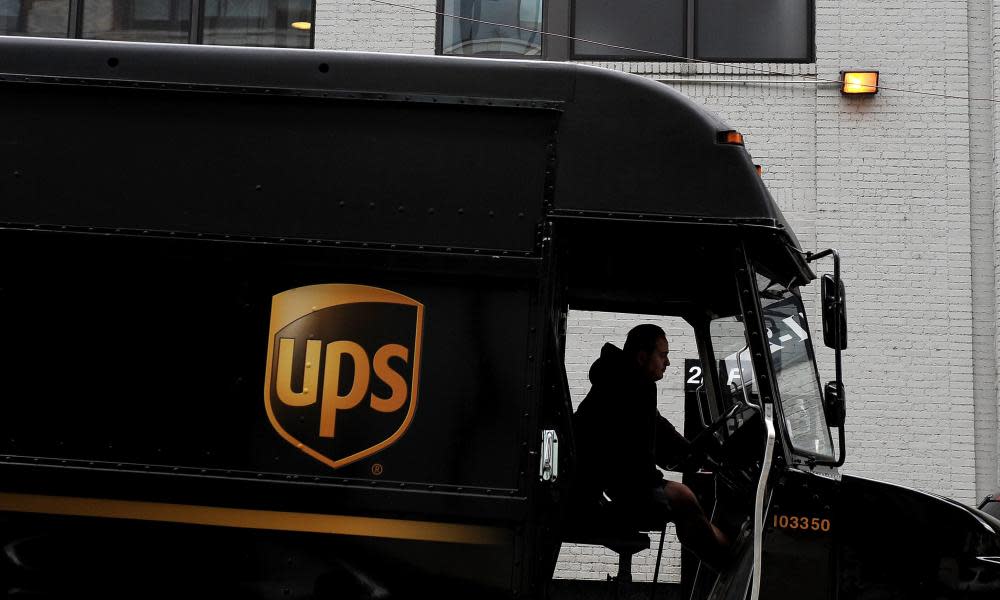UPS drivers push for air conditioning as temperatures soar: ‘People are dropping weekly’

As a UPS driver of two years standing, Matt Leichenger of Brooklyn, New York, makes 100 to 150 stops a day, delivering anywhere from 150 to more than 300 packages.
It is a tough job at the best of times, but in summer, a typical driver is moving hundreds of pounds of cargo and organizing packages in the back of their brown UPS truck, where temperatures soar due to a lack of air conditioning and ventilation.
Shifts can last up to 14 hours, and Leichenger has experienced the grueling toll soaring temperatures take on delivery drivers. He recently was denied a request for a fan to be installed in his truck – though a UPS spokesperson said the company provides fans to workers on request.
Related: Too radical or not radical enough? US’s top labor lawyer in the spotlight
“There’s a period of your day where at every stop you’re stepping into a hellhole. The second you step back there, you just feel all the sweat pouring out of your body,” said Leichenger.
The price some workers pay can be a deadly one. In early July in California, UPS driver Esteban Chavez, 24, collapsed and died while working as temperatures rose to the high 90s. A video from a Ring surveillance camera also went viral in July showing a UPS driver collapsing on a porch in excessive heat.
With contract negotiations set for next year, Leichenger and other workers represented by the Teamsters union are pushing for air conditioning in vehicles, better heat protection on the job, no more excessive overtime, higher pay for part-time workers, more full-time positions, and eliminating driver-facing surveillance cameras that are being installed in UPS trucks.
“We don’t have contractual language that guarantees us air conditioning, but I think this is something the federal government should really be stepping up to implement – not just at UPS, but for workers across every industry where extreme weather conditions are really taking a toll on workers,” Leichenger said.
Last week, the Teamsters demanded urgent details from UPS on the companies’ plans, training materials, and assessments on protecting workers from excessive heat. UPS reaped record profits last year, at $12.89bn, and reported $6.8bn for the first two quarters of this year.
“People are just dropping weekly here. It’s not something where that one driver in Arizona is going viral,” said Moe Nouhaili, a UPS driver in Las Vegas. “It’s not just the way that UPS is treating workers, it’s also how they’re making us work, expecting us to meet these unrealistic productivity numbers even through the weather.”
He said driver routes are determined by software called Orion, which calculates how long a route should take. Drivers face discipline if they exceed that time, despite excessive heat conditions, he said.
Raul Medina, a UPS driver in Chicago, said workers, including drivers and warehouse staff, are facing increased pressures over productivity, and have been given larger workloads, all while dealing with increasing temperatures fueled by the climate crisis.
“The amount of work we’re doing now has increased. The size and weight of the packages have increased, so we’re actually putting much more of a physical effort into it, along with the heat, and because of global warming, it’s not going to get any cooler. We’re going to see more hot days, and more consecutive hot days,” said Medina.
As the climate crisis worsens, workers are increasingly at risk of illness or death due to heat exposure on the job, with high heat index days of above 100F expected to double by mid-century. June 2022 tied with 2020 as the warmest June on record. Through July, numerous US cities experienced record-breaking temperatures and consecutive days of extreme heat amid global summer heatwaves.
According to data from the Bureau of Labor Statistics, 62 workers died in the US due to extreme temperatures in 2020, though fatalities and injuries from heat exposure are underreported.
Elliot Lewis, a driver in New York City, said the back of UPS trucks can reach 130F during hot summer days, and this has resulted in many of his co-workers getting sick.
He criticized UPS installing driver-facing surveillance cameras while refusing to install air conditioning. Lewis said the cameras add increased scrutiny to workers already fearful of taking breaks to cool off, get water, or go to the bathroom, as they could be disciplined and risk job termination.
“You see a lot of drivers, unfortunately, like at Amazon, peeing in the back of the truck, not drinking enough water, and ending up with heatstroke because they feel that pressure to be working faster,” he added.
A spokesperson for UPS characterized the surveillance cameras as a safety precaution and claimed the inward-facing cameras do not record audio or video but act as sensors to monitor for risky behavior.
“The data received from forward-facing cameras and inward-facing sensors is used by local UPS management teams to identify risky behaviors and provide in-person coaching and training,” said the spokesperson.
The spokesperson did not comment on air conditioning, but cited heat safety training, ventilation integration in vehicles, water and ice, and health and safety committees.
“UPS drivers are trained to work outdoors and to manage the effects of hot weather. Preparation, rest, hydration and maintaining good health practices are key to working outdoors. UPS invests more than $260m annually to implement programs focused on safety, including working in hot weather,” they said.
“We never want our employees to continue working to the point that they risk their health or work in an unsafe manner.”

 Yahoo Movies
Yahoo Movies 
